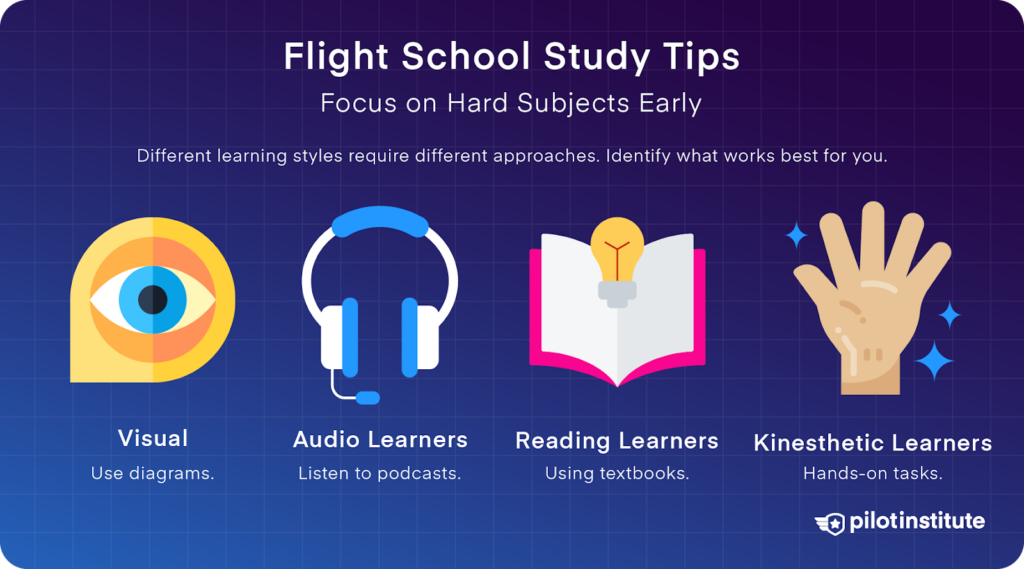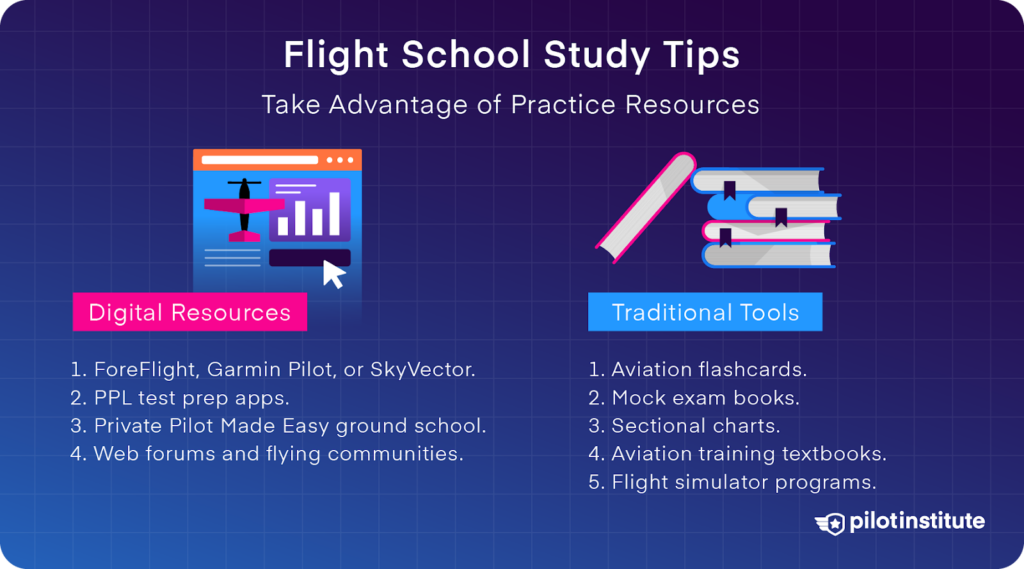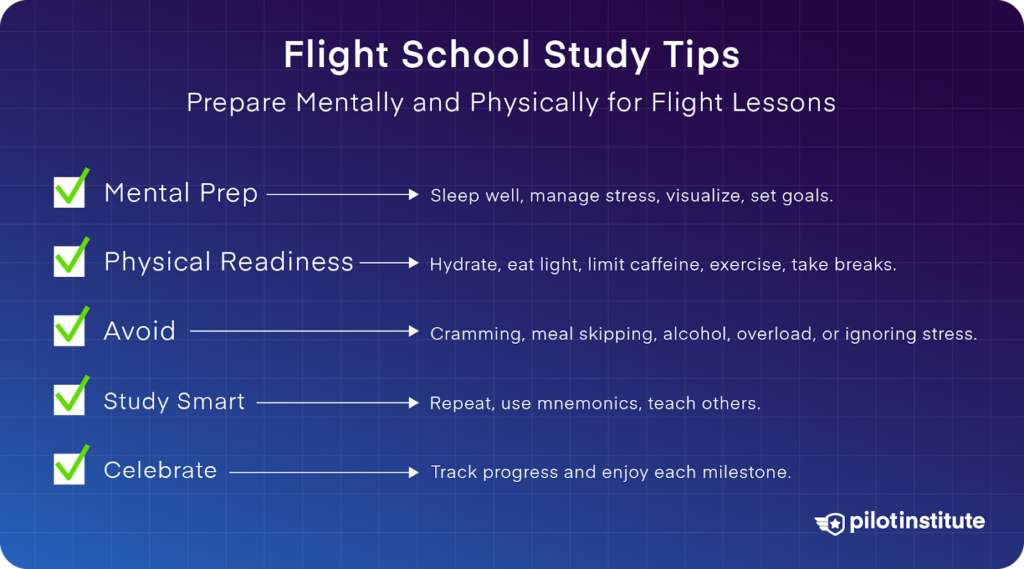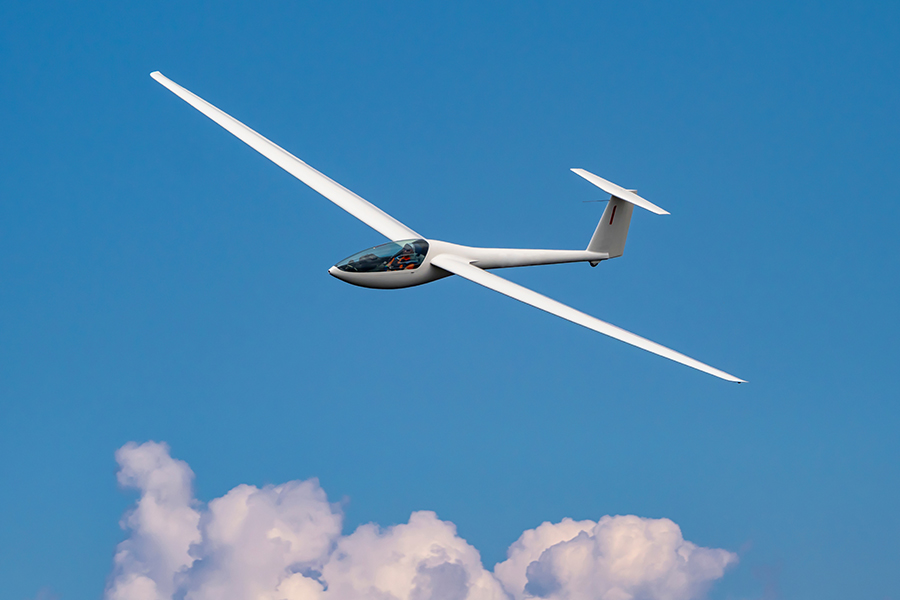-
Key Takeaways
-
Create a Study Schedule and Stick to It
- Create a Weekly or Daily Plan
- Dedicated Study Area
-
Focus on Hard Subjects Early
- 1. Visual Learners
- 2. Audio Learners
- 3. Reading Learners
- 4. Kinesthetic Learners
- Use the Pomodoro Learning Technique
- Start Ground School Early
-
Take Advantage of Practice Resources
- Digital Resources
- Traditional Tools
-
Join a Study Group
-
Prepare Mentally and Physically for Flight Lessons
- Mental Preparation
- Physical Readiness
- Things to Avoid
- Smart Study Strategies
- Celebrate Your Achievements
-
Conclusion
It might seem like you have to learn a ton of stuff all at once while becoming a private pilot. You’ve got to study from books, do tricky things in airplanes, and talk on the radio to air traffic controllers. It’s easy to feel stressed out and not know where to start.
But don’t worry, we’ve got some tips to help you balance your flying lessons and book smarts for your private pilot license.
Key Takeaways
- Create a structured daily study routine that matches your peak energy hours.
- Master complex subjects like weather and navigation early in your training journey.
- Use diverse learning tools, including flight simulators and mobile apps, to reinforce knowledge.
- Join study groups to maintain motivation and gain different perspectives on challenging topics.
Create a Study Schedule and Stick to It

Flying requires discipline, and that includes your study routine. Why do you need a schedule? A study schedule is like a flight plan, and you need one to help you organize, plan, and reach your goals.
Ever wondered why some days of studying feel harder than others? Start by identifying your peak energy hours. Do you think better in the morning or at night? Schedule your most challenging study sessions around those times.
Most importantly, break your study time into manageable blocks to meet your study goals. When you start losing focus, end the session and take a small break. This will help you prevent mental fatigue and maintain a high retention rate.
Create a Weekly or Daily Plan
Consider creating a weekly or daily schedule to balance your study time with flight training. Here’s a practical study strategy:
- Outline weekly goals based on your syllabus.
- Set aside times each day for studying.
- Use a digital calendar or a planner to monitor your progress.
- Include time for review and practice questions.
- Reward yourself for meeting study goals.
Dedicated Study Area
Try to find a dedicated study area that’s free from distractions. Just like a pre-flight checklist, develop a pre-study routine to remain focused. This might include organizing your materials, putting your phone on silent, and having water and snacks readily available.
Focus on Hard Subjects Early

Learning to fly is about more than just about stick and rudder skills. You will be better prepared for a career in aviation with a good understanding of weather, aerodynamics, and navigation. Learning these topics early on will make it easier for you to fly.
Different learning styles require different approaches. For example, you may need shorter study periods or more active breaks to remain attentive. So, you should try to identify what works best for you.
1. Visual Learners
If you’re a visual learner, you like to draw diagrams to understand concepts better. You might catch yourself doodling during ground school or creating a mental picture when studying aircraft systems. Visual students prefer using charts, graphs, and videos to learn new information.
- Regularly analyze weather maps.
- Study diagrams of aerodynamics and aircraft systems.
- Watch informative YouTube videos from Certified Flight Instructors.
- Create mind maps and visual summaries.
- Use color coding for different concepts.
2. Audio Learners
Aviation training can be like music to your ears if you prefer to learn through sound. You might find yourself repeating radio calls in your head or talking through procedures out loud. Auditory learners retain more information when they hear it explained rather than reading it from a textbook.
- Tune into aviation podcasts.
- Record and listen to your study notes.
- Participate in aviation seminars and workshops.
- Utilize audio study guides for ground school.
- Practice explaining complex ideas out loud.
3. Reading Learners
Aviation manuals are your best friends if you like to learn via text. Reading learners excel at processing information through textbooks, articles, and written explanations, making traditional ground school materials particularly effective for their learning style.
- Create detailed study guides and notes.
- Read different aviation textbooks.
- Keep a pilot journal to track your progress.
- Take online quizzes or tests.
- Make written checklists and flow diagrams.
4. Kinesthetic Learners
If you’re the type who needs to “do” to understand, you’re a kinesthetic learner. You might move your hands to explain concepts or walk through procedures physically. Hands-on learners prefer to touch, feel, and experience what they’re studying.
- Practice with flight simulator software.
- Use real or simulated scenarios to learn.
- Build model aircraft to understand systems.
- Physically walk through aviation procedures.
- Create physical flashcards.
Use the Pomodoro Learning Technique
The Pomodoro Technique is a great way for learning, especially for young students. This time management technique involves studying in focused bursts followed by short breaks.
Here’s the Basic Pomodoro Approach
- Study for 25 minutes.
- Take a 5-minute break.
- After completing 4 study sessions, you take a longer break of 15 to 30 minutes.
Start Ground School Early
Also, consider enrolling in ground school before you start flight training. This will build a solid knowledge foundation, making your flight school experience more enjoyable. Many pilots suggest completing at least half of ground school before starting flight lessons.
Take Advantage of Practice Resources

Today’s student pilots have access to a diverse range of learning tools. This can speed up the learning process and make it more exciting. Here are some resources that can aid in your training:
Digital Resources
- ForeFlight, Garmin Pilot, or SkyVector for flight planning and weather analysis.
- ASA Test Prep apps for practice questions.
- Join web forums and flying communities.
- E-learning platforms with interactive content.
- Online ground training schools such as “Private Pilot Made Easy”.
Traditional Tools
- Aviation flashcards for quick review sessions.
- Mock exam books from ASA or Gleim.
- Sectional charts for navigation practice.
- Aviation training manuals and textbooks.
- Flight simulator programs like X-Plane or Microsoft Flight Simulator.
Nowadays, simulators are more than just games, as they offer hyper-realistic training. Simulators allow you to practice procedures, develop muscle memory, and grasp complex flight maneuvers like steep turns or stalls. Many flight schools have started integrating simulator training into their programs.
Join a Study Group

Aviation is a community-driven field, so try to join a study group. Study groups provide many advantages that individual study simply can’t match.
Getting to know different viewpoints and learning styles can really help when it comes to tackling aviation topics. Plus, having support from peers can make a big difference in keeping you accountable and motivated.
Teaching others is also a great way to improve your own understanding. Study groups have one more benefit. Sharing resources and study materials can make the learning journey a lot easier and fun.
If you can’t find a local study group, consider starting one. Most training centers and flight schools are open to student-led study initiatives. Online study groups via Zoom or Discord can also be useful, offering different perspectives from students around the globe.
Prepare Mentally and Physically for Flight Lessons

Success in flight school depends on your mental readiness and physical fitness. That’s why you must stay focused, well-rested, and alert during your flight lessons. Here are some tips to assist in your preparation:
Mental Preparation
- Aim for 7 to 8 hours of sleep before training days.
- Practice stress-management techniques like meditation.
- Review your study materials before bed for better retention.
- Visualize procedures and maneuvers during your downtime.
- Set achievable goals and monitor your progress.
Physical Readiness
- Stay well-hydrated, as dehydration affects cognitive function.
- Avoid heavy meals before flights to maintain alertness.
- Limit caffeine consumption before lessons to avoid jitters.
- Exercise regularly to boost energy levels and reduce stress.
- Take frequent breaks to prevent fatigue.
Things to Avoid
- Cramming the night before a flight lesson or test.
- Skipping meals or depending on energy drinks.
- Consuming alcohol within 24 hours of flying.
- Overloading yourself with information right before checkrides.
- Ignoring signs of stress or burnout.
Smart Study Strategies
- Repetition is key, so keep practicing.
- Use mnemonics to remember concepts, such as GUMPS.
- Practice teaching friends or family who aren’t pilots.
Note: Daily studying, practice, and repetition will make you more confident in the cockpit.
Celebrate Your Achievements
Just remember, your flight training journey is unique. These study tips are not strict rules but tools you can use to adapt to your learning style. Each concept you master brings you closer to your aviation goals. So, continue to keep track of your progress and achievements.
Conclusion
Flight school definitely is not easy, but with discipline and the right study techniques, you will succeed. Focus on those hard subjects first, and use different online ground schools and tools to help you grasp everything. If one learning method doesn’t suit your learning style, try another.
As long as you persevere, you will make it!


